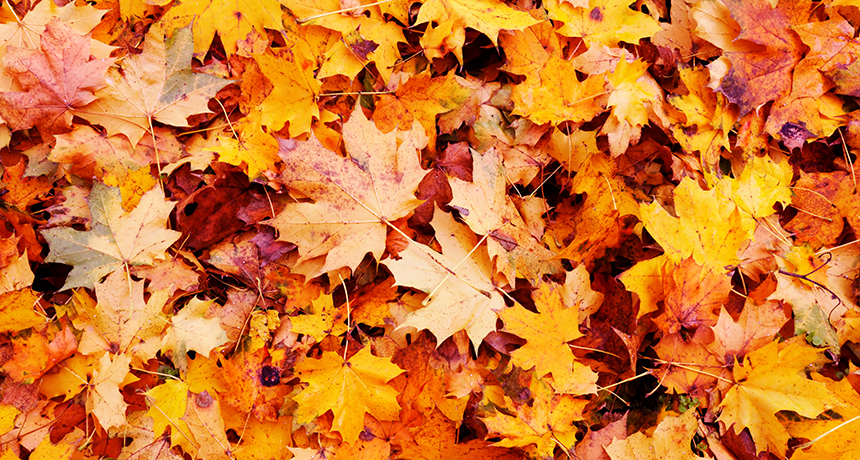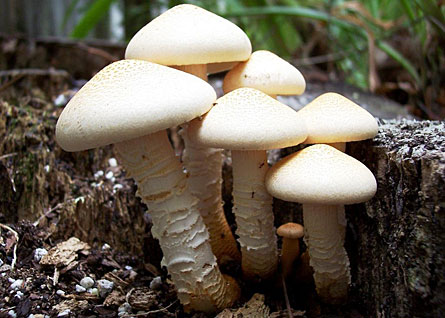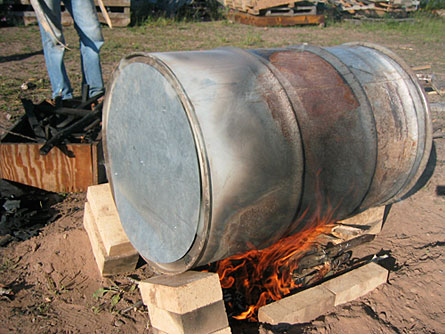Getting the dirt on carbon
The circle of life continues thanks to the carbon cycle

As part of the carbon cycle, leaves decompose and the carbon in their bodies is broken down and recycled. Some of it is released into the air as carbon dioxide, or CO2. The rest moves into the soil.
zorankrstic/iStockphoto
By Susan Gaidos
Each year, spring comes, plants bloom and the trees leaf out in their full green glory. Come fall, while diving into piles of fallen leaves, you may think the life cycle of the leaf has come to an end.
But that’s not so. Once a leaf hits the dirt, a new cycle begins. All those brightly colored leaves are like candy for fungi and bacteria on the ground. These decomposers, organisms that feed on dead matter, go to work breaking down leaves to create energy-filled food for themselves. In the process, decomposers also make nutrients available for other organisms.
This recycling scheme is not just a plot to produce a mob of mushrooms and other eensy entities. It’s part of a complex chemical cycle that helps regulate the Earth’s climate. And it’s all based on carbon, a kind of element, or tiny substance.
Carbon is the building block for all life on Earth. Every single cell in every living thing — including plants, animals and humans — contains at least some of the stuff.
Carbon isn’t found only in living matter. It’s also found inside the Earth’s mantle, the layer between the crust and the core, and in seawater, air, rocks and soil. The planet’s carbon is constantly flowing from one of these to another, creating what is known as the carbon cycle.
Take those leaves, for example. As they decompose, or rot, the carbon in their bodies is broken down and recycled. Some of it is released into the air as carbon dioxide, or CO2. The rest moves into the soil.
Soil is a great place for carbon. There, it may remain locked up for hundreds, thousands or even millions of years, adding nutrients needed for growing food. Keeping carbon locked up in the soil also provides a way to keep it out of the atmosphere.
Dig in
Carbon has a very complicated cycle within the soil and in the atmosphere. The two cycles are intricately linked, says Patrick Drohan, a pedologist (scientist who studies soil) at Pennsylvania State University in University Park.
Though some of the carbon in soil comes from sedimentary rocks, such as limestone, most of it comes from organic matter, meaning waste from living organisms. Sounds a bit yucky, but it’s really cool. He explains the cycle like this:
A squirrel poops (or a plant or animal dies) and the waste then decomposes. Nutrients in the organic matter, including carbon, are released into the soil with the help of decomposers such as fungi and bacteria. Over the years, the nutrients are broken down further. Eventually, the nutrients get reabsorbed by a plant taking up water, or a human eating food grown in the soil or perhaps by a tiny organism called a microbe within the soil. When that microbe breathes, it releases CO2 into the atmosphere. Plants absorb the CO2 released from the microbe. From here, the cycle begins again.
 |
|
Leaves on the ground are like candy for fungi and bacteria. These decomposers, organisms that feed on dead matter, go to work breaking down leaves to create energy-filled food for themselves. In the process, decomposers also make nutrients available for o
|
| Karl Lipschitz/stock.xchng |
Concern over the rapid buildup of carbon dioxide in the atmosphere has prompted scientists to look at ways to sequester, or contain, carbon in the soil and plants. The key to doing this is plant production.
Scientists say promoting and protecting the growth of forests and other plants may boost plants’ capacity to take up CO2 in the atmosphere. Such practices may also increase soils’ capacity to store carbon for long periods of time.
The power of plants
Most of the carbon on Earth is stored in plants and soil.
Where does all this carbon come from? Plants get all of their carbon from carbon dioxide, or CO2, in the atmosphere. The leaves on trees and crops soak up CO2 during photosynthesis, a chemical process that converts sunlight into food. Then plants spit some of the CO2 back out during another process called respiration, the way plants “breathe.”
Plants, especially trees, are so efficient at pulling carbon dioxide from the air that they take in more carbon than they release. That’s why they’re called “carbon sinks.”
Trees grouped together in forests are even more efficient. Scientists estimate that the Earth’s forests currently store more than 75 percent of the planet’s aboveground carbon. And the forests store almost that much of the planet’s soil carbon.
Scientists are working to develop forest management strategies to help absorb some of the extra CO2 in the atmosphere. But this task isn’t as straightforward as it may seem.
Not all forests actually store carbon, says Peter Curtis, a forest ecologist at Ohio State University in Columbus who studies the role of forests in the carbon cycle. “Some forests experience a net loss.”
That doesn’t mean that the trees have stopped photosynthesizing. It simply means that the respiration part, the loss, is greater than the gain, he explains.
Accounting for carbon
Curtis works to measure how much carbon can be held in forests in the Midwest and Great Lakes region. Working from the University of Michigan Biological Station in northern Michigan, he has two ways of doing that.
First, he uses a high-tech approach: Information is collected on and around two meteorological, or weather-measuring, towers, which look a lot like cell phone towers. Standing 150-feet-tall — about as high as a 15-story building — the towers loom over the forest’s canopy.
Instruments on the towers measure how much CO2 is being taken up by the leaves on the trees. The instruments also measure temperature and moisture levels in the air, recording information up to 10 times per second.
The scientists also use some “low-tech” methods to collect data. In other words, researchers spend lots of time on the ground measuring the trees and collecting leaves to see how much debris has decomposed.
Using this information, Curtis tracks how much carbon the forests take in through photosynthesis, and how much they lose through respiration.
 |
|
Carbon is the building block for all life on Earth. Every single cell in every living thing — including flowers, frogs and humans — contains at least some of the element.
|
| Keith Weller/USDA-ARS |
“It’s like a bank account,” he says. “If you get $10 in allowance, but have $8 in expenses, then $2 is what goes into your account.”
The trees may take up a ton of CO2 per acre, but respire 1,500 pounds, leaving a “profit” of 500 pounds of carbon intake.
Fortunately, most forests take in more carbon than they loose. Generally speaking, the planet’s forests take in about 25 percent of the CO2 created by human activities, Curtis says.
Areas heavily populated with forests absorb even higher amounts of human-generated CO2. In some parts of Michigan or Maine, the oaks and pines found in hardwood forests take up about 60 percent of the carbon emitted by people that live in that area.
“A forest in one of these areas can soak up the yearly emissions of about 225,000 cars,” Curtis says. “We call that an ecological forest.”
But changes in rainfall and temperature can shift a forest’s ability to hold carbon from year to year. Unseasonably warm temperatures in a cool, wet forest, for example, can speed the rate of decomposition of soil matter. When that happens, carbon that has been stored in the soil for hundreds, even thousands of years, may be released back into the atmosphere.
Such changes have been documented in some Canadian forests, Curtis says. “This is one of the big worries with climate change. When temperatures increase, decomposition ramps up and the forest gets drier, and all that soil carbon starts to be lost.”
Small changes
Scientists don’t yet know all the effects climate change will have on soil’s ability to store carbon, Drohan says.
They do know, however, that even a small change in soil carbon storage can have a significant impact on the global carbon balance. To that end, researchers are looking at ways farmers might better manage their crops and soil.
Practices designed to keep carbon in the soil will benefit farmers, as well as the planet. Carbon adds organic matter, which helps soil retain nutrients and water. Soil carbon also improves the structure of soil, resulting in better drainage and aeration, or flow of gases, for roots. That means healthier plants and better yields for farmers.
You don’t have to be a farmer to benefit, or to help. Curtis spends some of his time working with government officials and landowners to help them manage forest areas for the benefit of the planet and its soil.
 |
|
At Michigan Technological University, faculty and students are leading a community effort to return carbon to the soil. The group throws logs and other debris into a large container. These scraps are then burned slowly at a low temperature to create bioch
|
| Michigan Technological University |
Even small-scale, community efforts can help. At Michigan Technological University, faculty and students are leading a community effort to return carbon to the soil. Instead of just letting agricultural and plant wastes degrade on their own, the group throws logs and other debris into a large container. These scraps are then burned slowly at a low temperature.
This smoldering process produces a substance called biochar that resembles the char left by a campfire. More importantly, the slow burn prevents much of the carbon from getting released back into the air, says Michael Moore, who’s leading the effort. The char can then be tilled right into the soil, where the carbon stays locked for years.
Amazonian natives have used this technique for centuries to fertilize their soil, says Moore, who teaches writing and poetry. He learned about it while traveling in Honduras.
Biochar isn’t ready for large-scale agriculture yet, but Moore says such community efforts provide a way for ordinary citizens to help the planet. And that has benefits for all.







